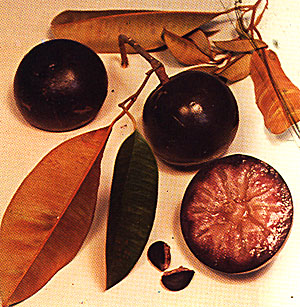CSMS Magazine Staff Writer
One of the most relatively minor of the Sapotaceae is the star apple or golden-leaf tree, Chrsophyllum canito L. (syn.Achras caimito Ruiz & Pavon). It has acquired a moderate assortment of regional names. In Spanish, it is usually camitto or estrella. In Portuguese, canitio or ajara. In French generally caimite or caimitier. In Haiti, pied caimite or cammiter à feuilles d’or in the other francophone islands of the Caribbean pomme surette or buis.
Description
The star apple is erect, 25 to 100 ft (8-30m) tall, with a short trunk to 3ft( 1m) thick, and dense, broad crown, brown-hairy branchlets, and white, gummy latex. The alternate, nearly evergreen, leaves are ecliptic or oblong 2 to 6 in long, slightly leathery, rich green and glossy on the upper surface, coated with silky, golden-brown pubescence beneath which mature, though silvery when young. Small, inconspicuous flowers, clustered in the leaf axils, are greenish yellow, or purplish-white with tubular, 5-lobed corolla and 5 or 6 sepals. The fruit, round, oblate ellipsoid or somewhat pear-shaped, 2 to 4 in (5-10cm) in diameter, may be red-purple, dark-purple, or pale green. It feels like a rubber ball. The glossy, smooth, thin, leathery skin adheres tightly to the inner rind which in purple fruits, is dark purple and ¼ to ½ in (6-12.5mm).
Origin and Distribution
It is commonly stated that the star apple is indigenous to Central America but the eminent botanist Paul Standley and Louis Williams have declared that it is not native to that area, no Nahutal name has been found, and the tree may properly belong to the West Indies. However, it is more or less naturalized at low and medium attitudes from Mexico to Panama, and it is especially abundant on pacific side of Guatemala, and frequently cultivated as far south as northern Argentina and Peru. It was recorded by Ciezo de Leon as growing in Peru during his travels between 1532 and 1550. It is common throughout most of the Caribbean Islands and in Bermuda. In Haiti, the star apple was favorite fruit of King Henri Christophe. The United States Department of Agriculture received seeds from Jamaica in 1904. The star apple is grown in southern Florida and in Hawaii where it was introduced in 1901. The tree is also grown in southern Vietnam and in Kampuchea or Cambodia for its fruits but more for its ornamental value in West Africa.
Varieties
Apart from the two distinct color types, there is little evidence of such pronounced variation that planters would be able to stimulate to make vigorous efforts to select and propagate superior clones. Farmer and Scientist William Whitman of Miami observed a tree yielding heavy crops of well-formed, high quality fruits in Port-au-Prince, Haiti from late January to the end of June. He brought budwood to Florida in 1953. Grafted progeny and trees grown from air-layers have borne well here even prior to reaching 10ft (3m) in height. This introduction, named the “Haitian Star Apple”, is propagated commercially for dooryard culture.
Propagation
Star apple trees are most widely grown from seeds which retain viability for several months and germinate readily. The seedlings bear 5 to 10 years. Vegetative propagation hastens production and should be more commonly practiced.


